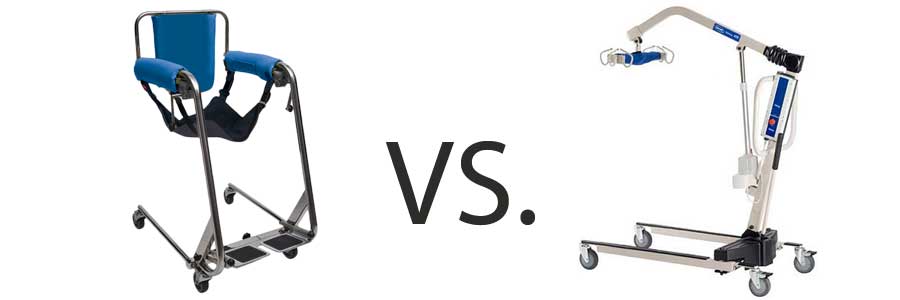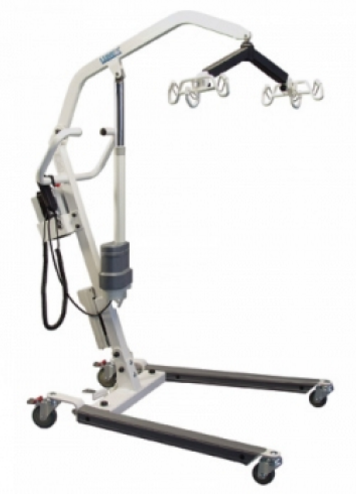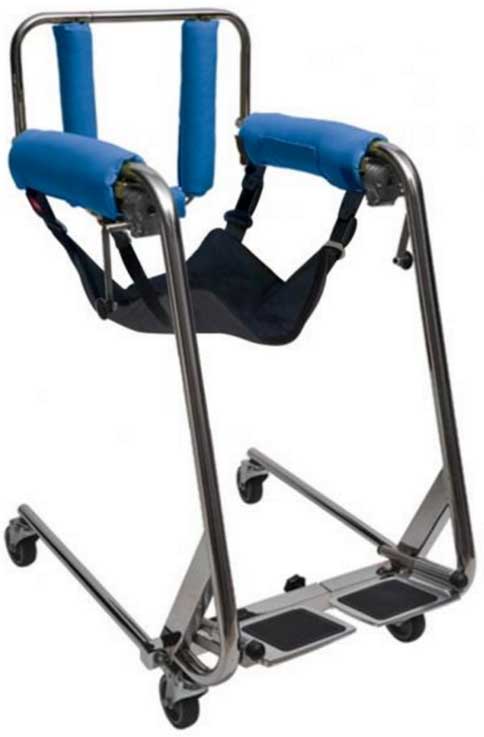
Date: May 26, 2016
By Burt Cancaster

Patient Lift Review and Comparison
Patient lifts lift patients who require mobility assistance to transfer from a bed to the bath, commode, chair, or automobile. Patient lifts are safety devices that protect mobility patients as well as caregivers from injuries. Just a few years ago, transporting a patient from one furnishing to another was significantly dangerous. Numerous medical studies demonstrate that modern lifting technology provides the safest way to transfer patients from one furnishing to another. See the list of reviews below.
Patient lift construction is with thick, heavy steel frames and an electric or manual hoisting mechanism. Most of these medical hoists are primarily hydraulic lifts for people. Unfortunately, most of the existing patient lifts available for hospital and home use are large and heavy. Often they require several caregivers to assist the patient and to manipulate the lift through narrow doorways, hallways, and around furniture and other obstacles. The large size and heavy weight are often considered a burden by caregivers even though these lifting devices provide a safer way to transfer mobility patients. If only a smaller and more lightweight patient hoist was available, that could do the same job!
Body Up Evolution Review
Body Up Evolution is significantly different from existing patient lifts. Instead of a heavy steel frame, the Body Up uses a lightweight stainless steel frame, a durable canvass sling, and a manual crank mechanism. These three items combine to lift a patient from a seated position safely. After lifting, it is easy to transfer to the bed to a bed, bath, or car. Using a simplified design, the Body Up Evolution Patient Lift is easier to use and operate. Most often, only one caregiver is required to assist the patient and transfer them to another furnishing. (See the video below to see the Body Up Evolution being used to transport a patient) Equipped with 4-caster-type wheels, this transfer chair makes it easy to push thru hallways and narrow doorways. Moving patients from one room to another is now much more accessible than ever before.
The Body Up Evolution has optional accessories that make this transfer lift chair even better. These accessories convert the Body Up to a commode chair, shower chair, bath chair, transport chair or transfer chair. These accessories include stabilization straps to secure the patient to the Body Up, a comfort cushion to make transfers and sitting more comfortable and a commode cushion to make toileting even easier. Mobility patients are easily lifted and moved by a single caregiver. Join the revolution with the Body Up Evolution!
How does the Body Up Lift compare with the top-selling patient lifts? For this review of patient lifts, we will compare the Body Up with the Graham-Field Easy Lift, the Invacare Hydraulic Patient Lift, the Medline Powered Base Electric Lift, and the Hoyer Advance Professional.
The Hoyer Advance Professional has the overall smallest minimum size at 14,733 cubic inches, significantly smaller than the other lifts. The Hoyer's minimum height is also the lowest at 13.8 inches. The Veziris Body Up lift has the lowest weight at 42 pounds and the shortest length at 34.7 inches. Ranking #1 for the most lightweight lift, the Body Up Evolution is the most adaptable for use by a single caregiver. Its key feature of providing a 4-in-1 patient device earns it a #1 ranking for features. This lift functions as a bath lift chair, shower lift chair, commode lift chair, and a transfer lift. Its stainless steel frame and waterproof canvass make this lift chair easy to use for bathing or showering. The data below indicated in yellow highlight signifies category leadership.
Patient Lifts Comparison
Patient Lift Resources
- Baptiste, Andrea, et al. "Proper sling selection and application while using patient lifts." Rehabilitation Nursing 33.1 (2008): 22-32.
- Capaldi, Guido, and Mark G. Sinreich. "Patient lift mechanism." U.S. Patent No. 5,809,591. 22 Sep. 1998.
- Dehlin, O., and Eva Jäderberg. "Perceived exertion during patient lifts. An evaluation of the importance of various factors for the subjective strain during lifting and carrying of patients. A study at a geriatric hospital."Scandinavian journal of rehabilitation medicine 14.1 (1981): 11-20.
- Evanoff, Bradley, et al. "Reduction in injury rates in nursing personnel through introduction of mechanical lifts in the workplace." American journal of industrial medicine 44.5 (2003): 451-457.
- Holliday, Pamela J., G. R. Fernie, and S. Plowman. "The impact of new lifting technology in long term care: a pilot study." AAOHN journal: official journal of the American Association of Occupational Health Nurses 42.12 (1994): 582-589.
- Li, Jie, L. Wolf, and Bradley Evanoff. "Use of mechanical patient lifts decreased musculoskeletal symptoms and injuries among health care workers." Injury Prevention 10.4 (2004): 212-216.
- Nelson, Audrey, et al. "Safe Patient Handling and Movement: Preventing back injury among nurses requires careful selection of the safest equipment and techniques. The second of two articles." AJN The American Journal of Nursing 103.3 (2003): 32-43.
- Garg, A., et al. "A biomechanical and ergonomic evaluation of patient transferring tasks: wheelchair to shower chair and shower chair to wheelchair." Ergonomics 34.4 (1991): 407-419.
- Newman, William Chris, and George D. Tipp. "Patient transfer assist device." U.S. Patent No. 5,711,044. 27 Jan. 1998.
Body Up Evolution Video (6:01 minutes)



